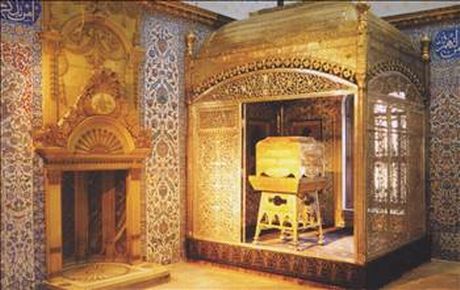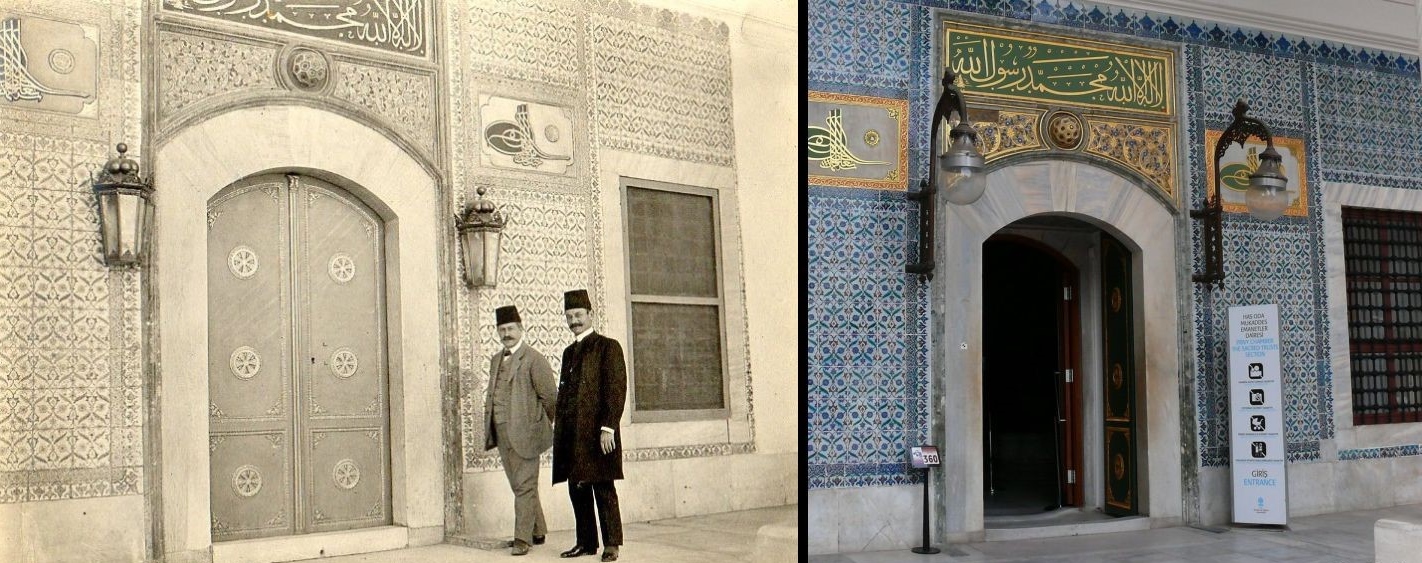(1).jpg)
THE CHAMBER OF THE BLESSED MANTLE: A TREASURE OF HISTORY
The most valuable sacred relics, which had been gathered in Istanbul since the Byzantine period, were brought here after Sultan Selim I’s conquest of Egypt. In the following years, many more sacred items reached the palace through various means.

Invaluable Treasures
The most important item among the Holy Relics (Amanat al-Muqaddasa) is the Blessed Mantle (Khirqa al-Sa‘ada) that the Prophet Muhammad gifted to Ka‘b ibn Zuhayr due to his famous ode. The chamber where the relics are preserved takes its name from this mantle. On every Night of Power (Laylat al-Qadr, an Islamic festival that commemorates the night on which Allah first revealed the Qurʾan to the Prophet Muhammad through archangel Jibril), the sultan, accompanied by his entourage, would ceremoniously visit this mantle. Handkerchiefs placed on the mantle for the purpose of kissing would be distributed to the visitors. The Blessed Mantle (Khirqa al-Sharifa) associated with Uways al‑Qarani, which is visited during Ramadan in the mosque of the same name in Fatih, is different.
The Chamber of the Blessed Mantle also houses the following items: the sacred banner (Liwa’ al-Sharif) belonging to the Prophet Muhammad, which accompanied Ottoman armies on campaigns and is now kept in a box due to heavy wear; letters sent by the Prophet Muhammad to the Governor of Egypt Muqawqis, the Governor of Al-Ahsa Mundhir, the false prophet Musaylima, and the Ghassanid king al-Harith; Qur’anic manuscripts; the Prophet Muhammad’s tooth broken at Uhud, whose jeweled casing was made by Sultan Mehmed VI (Dandan al-Sa‘ada); hairs from the Prophet Muhammad’s beard (Sha‘r al-Sharif / Lihyat al-Sa‘ada); his bow (Qaws al-Nabawi), with its silver case made by Sultan Ahmed I; his staff and swords; his footwear (Na‘layn al-Sharifayn); his footprint (Naqsh Qadam al-Sa‘ada); a copy of his agate seal engraved with “Muhammad, the Messenger of Allah” in three lines; and his water bowl, covered in silver.
Also present are: the shirt of Fatimah (later inscribed with talismans), a camel-hair-colored, blue-lined, buttoned wool mantle with a collarless wide sleeve attributed to her; the collarless, short-sleeved white shirt and a bloodstained piece of garment belonging to Husayn.

A Journey Through Prophetic History
The Prophet Musa's (Moses) 122 cm-long staff; the Prophet Yusuf's (Joseph) brown felt cap with a white turban, worn by some sultans during their accession ceremonies; the Prophet Ibrahim's (Abraham) granite cooking pot; and bone fragments from the arm and skull of the Prophet Yahya (John), kept in a golden case.
.jpg)
There are also swords (Suyuf al-Mubaraka) attributed to: two to the Prophet Muhammad, one to the Prophet Dawud (David), one to Abu Bakr, three to ‘Umar, five to ‘Uthman, one to ‘Ali, four to Khalid ibn al-Walid, two to Mu‘adh ibn Jabal, one to ‘Ammar ibn Yasir, one to Ja‘far al-Tayyar, one to Zubayr ibn al-Awwam, one to Sa‘d ibn ‘Ubada, one to Dirar ibn Azwar, two to unnamed Companions (Sahaba), and one to Zayn al-‘Abidin.
The chamber also includes relics of holy places: locks and keys of the Ka‘bah; casings of the Black Stone (Hajar al-Aswad); the door wing of the Door of Repentance (Bab al-Tawba); gutters from the Ka‘bah; the Ka‘bah door, covers of the Rawda (the Prophet’s tomb area) and its pulpit; grave covers belonging to the Prophet Muhammad, Abu Bakr, ‘Umar, and Fatimah; a prayer rug and wedding veil associated with Fatimah; the cap of Uways al‑Qarani; the robe of Imam al-A‘zam (Abu Hanifa); and many other items.
.jpg)
Forty Qur’an Reciters in the Chamber of the Blessed Mantle
Today, the majority of these relics (approximately 600 pieces) are exhibited in the Holy Relics Section of the Topkapı Palace, while some are displayed in the treasury, weapons, textiles, and library sections. Previously, they were preserved in the Imperial Treasury (Khazina al-Humayuniyya) and attended to by special students and servants of the Enderun (Palace) School assigned to this duty. Sultan Mahmud II moved them to the Privy Chamber (Has Oda). Forty chamberlains, including the sultan himself, were responsible for cleaning, preserving, and burning incense there. During World War I, the Holy Relics were transferred to Konya due to fears of bombing, and during World War II, to Niğde.
.jpg)
Ceremonies such as the pledge of allegiance to a new sultan, the Irsal al-Lihya (beard-growing ceremony), and prayer, the wedding of princesses, departure for military campaigns, and the washing of the bodies of deceased sultans and princes used to take place in front of this chamber. The dust collected during cleaning was preserved in a special well. The key to the Chamber of the Blessed Mantle was kept by the sultan, and it was visited ceremonially on the Laylat al-Qadr. Since the time of Sultan Selim I, forty Qur’an reciters continuously recited the Qur’an here. This tradition was interrupted during the Republic era but was later revived.
The Water of the Blessed Mantle
The Blessed Mantle was traditionally visited once a year after the 15th day of Ramadan by the sultan and state officials. This tradition began with Sultan Selim I and continued until the last Ottoman sultan, Sultan Mehmed VI. On the Laylat al-Qadr, the sultan would come to the Chamber of the Blessed Mantle. The chief of the linen keepers would bring rose water in silver bowls with about 60 new sponges. The silahdar agha (sword-bearer) would take several sponges, dip them in the rose water, and hand them to the sultan, who would personally clean the large silver grille housing the Blessed Mantle container.
At the same time, all the chamberlains, led by the chuhadar agha (master of the robes) and rikabdar agha (master of the stirrup), would also take sponges, dip them in rose water, and clean every part of the room.
The ceremonial visit began the next day about two hours before noon prayer. After the sultan entered the Chamber of the Blessed Mantle, the chamberlains would bring out the chest containing the mantle from within the silver grille and place it on its gold stand. The golden key to the chest was kept by the sultan himself. The sultan would open the chest by reciting the basmala (Bismillah). The mantle was wrapped in a bundle, which was placed inside a gold drawer, itself wrapped in seven bundles, and all of this was housed inside a gold box. The seven richly embroidered bundles were bound with thick pearl-adorned ribbons. The ribbons would be untied, the bundles opened, and the golden drawer unlocked with the sultan’s key. Finally, the last bundle would be untied, and the sacred mantle would be revealed.
The visit consisted of kissing the collar of the mantle from the right shoulder side. The mantle itself was not kissed directly; instead, a muslin cloth (tulband) would be placed over the spot, and it would be kissed. Several hundred such muslin cloths were prepared in advance for the day. Every visitor would take the tulband they kissed the mantle through as a sanctified keepsake. The state officials, palace members, harem residents, and all the zuluflu aghas (elite palace pages) of the Enderun School visited the mantle in a strict ceremonial order.
Throughout the visit, the sultan would stand by the golden drawer, with the grand vizier on his right and the chief eunuch on his left. The chamberlains would recite the Qur’an aloud during the entire ceremony.
After the visit, the sultan himself would lock the golden drawer and chest, and the chamberlains would return the chest to its place behind the silver grille.
There was once another tradition during this visit. When the last bundle was untied and the mantle revealed, the button on its collar would be dipped in rose water in a silver bowl and moistened. Then, that wet part of the mantle would be gently dried over a censer with amber. The rose water in which the collar and button had been dipped would be poured, a few drops at a time, into hundreds of pre-prepared jugs of drinking water. These jugs were then gifted to notable individuals under the name “Water of the Blessed Mantle” (Ma’ Khirqat al-Sa‘ada). It was believed to cure various ailments, especially paralysis. Sultan Mahmud II abolished this tradition because some opportunists had started selling jugs of regular fountain water with a few drops of rose water to the gullible public of Istanbul as “Water of the Blessed Mantle,” turning it into a commercial venture.
Önceki Yazılar
-
THE FIRST UNIVERSITY IN THE WORLD WAS FOUNDED BY MUSLIMS3.12.2025
-
WHO BETRAYED PROPHET ISA (JESUS)?26.11.2025
-
IT HAS BEEN MORE THAN 100 YEARS SINCE ITS ABOLITION, BUT... IS THE CALIPHATE BEING REESTABLISHED?19.11.2025
-
GREETINGS TO YOU, O OTTOMAN SANJAK!…12.11.2025
-
ROTHSCHILDS BROUGHT THE END OF THE OTTOMAN EMPIRE!5.11.2025
-
SHEIKH BEDREDDIN, SON OF THE QADI OF SIMAVNA29.10.2025
-
THE ROOTS OF THE ENGLISH POLITICIAN IN TURKEY – THE TRAGIC END OF ALI KEMAL BEY22.10.2025
-
WHERE IS THE RED APPLE?15.10.2025
-
THE ABBASIDS IN ANATOLIA1.10.2025
-
IMAMS AND MUFTIS AS OFFICERS IN THE OTTOMAN ARMY24.09.2025